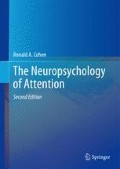Abstract
A fundamental premise underlies the neuropsychological approach within this book that attention and other cognitive functions are biophysical phenomena that can be operationalized, empirically studied and ultimately characterized and understood. A monistic perspective is assumed such that (1) reality is a unified whole, (2) all of its manifestations can be accounted for by empirical study and ultimately a single system of knowledge, and (3) the mind and body (or more broadly all physical matter) originate from and are reducible to the same substance and common laws and principles. The framework fits most closely with neurophilosophy and with epistemologies that reject dualistic conception of the mind and body as distinct entities, such that the mind is not knowable through the study of physical phenomena. On the other hand, it also assumes that there are multiple paths by which cognition and other “mental” experiences can be studied.
Access this chapter
Tax calculation will be finalised at checkout
Purchases are for personal use only
References
Schneider, W., & Shiffrin, R. M. (1977). Controlled and automatic human information processing: I. Detection, search, and attention. Psychological Review, 84, 1–66.
Shiffrin, R. M., & Schneider, W. (1977). Controlled and automatic human information processing: II. Perceptual learning, automatic attending and a general theory. Psychological Review, 84, 127–190.
Hasher, L., & Zacks, R. T. (1984). Automatic processing of fundamental information: The case of frequency of occurrence. American Psychologist, 39, 1372–1388.
Mirsky, A. (1989). Neuropsychology of attention: Elements of a complex behavior. In E. Perecman (Ed.), Integrating theory and practice in clinical neuropsychology (xxviii, 438 p). Hillsdale, NJ: Lawrence Erlbaum.
Heilman, K. M., & Valenstein, E. (1979). Mechanisms underlying hemispatial neglect. Annals of Neurology, 5(2), 166–170.
Friston, K. J., & Buchel, C. (2000). Attentional modulation of effective connectivity from V2 to V5/MT in humans. Proceedings of the National Academy of Sciences of the United States of America, 97(13), 7591–7596.
Deco, G., & Rolls, E. T. (2004). A neurodynamical cortical model of visual attention and invariant object recognition. Vision Research, 44(6), 621–642.
Slotnick, S. D., Schwarzbach, J., & Yantis, S. (2003). Attentional inhibition of visual processing in human striate and extrastriate cortex. NeuroImage, 19(4), 1602–1611.
Bender, D. B., & Youakim, M. (2001). Effect of attentive fixation in macaque thalamus and cortex. Journal of Neurophysiology, 85(1), 219–234.
Mehta, A. D., Ulbert, I., & Schroeder, C. E. (2000). Intermodal selective attention in monkeys. II: physiological mechanisms of modulation. Cerebral Cortex, 10(4), 359–370.
van Schouwenburg, M. R., den Ouden, H. E., & Cools, R. (2010). The human basal ganglia modulate frontal-posterior connectivity during attention shifting. Journal of Neuroscience, 30(29), 9910–9918.
Cummings, J. L., Gosenfeld, L. F., Houlihan, J. P., & McCaffrey, T. (1983). Neuropsychiatric disturbances associated with idiopathic calcification of the basal ganglia. Biological Psychiatry, 18(5), 591–601.
Castellanos, F. X. (1997). Toward a pathophysiology of attention-deficit/hyperactivity disorder. Clinical Pediatrics, 36(7), 381–393.
Author information
Authors and Affiliations
Rights and permissions
Copyright information
© 2014 Springer Science+Business Media New York
About this chapter
Cite this chapter
Cohen, R.A. (2014). Neuropsychology of Attention: Synthesis. In: The Neuropsychology of Attention. Springer, Boston, MA. https://doi.org/10.1007/978-0-387-72639-7_28
Download citation
DOI: https://doi.org/10.1007/978-0-387-72639-7_28
Published:
Publisher Name: Springer, Boston, MA
Print ISBN: 978-0-387-72638-0
Online ISBN: 978-0-387-72639-7
eBook Packages: MedicineMedicine (R0)

